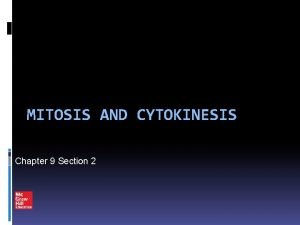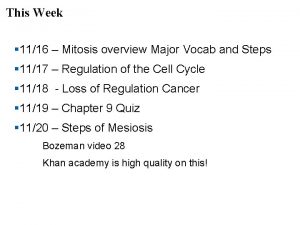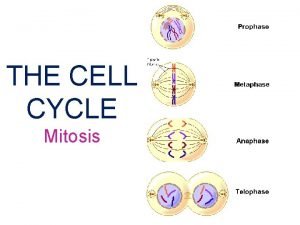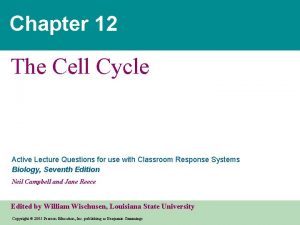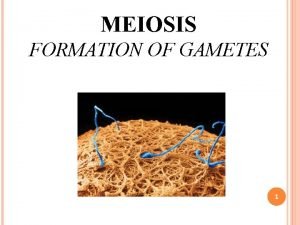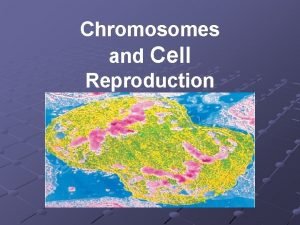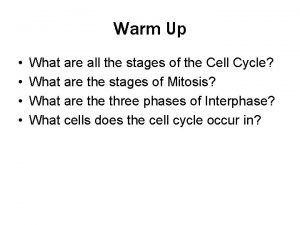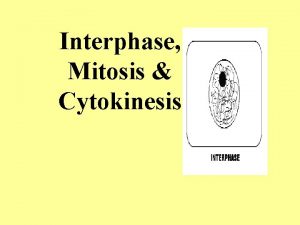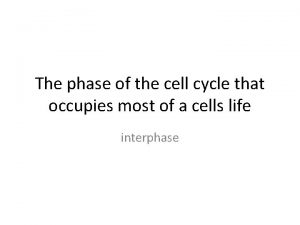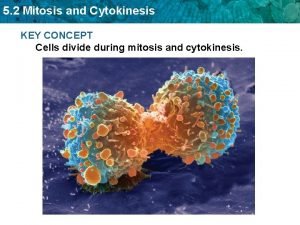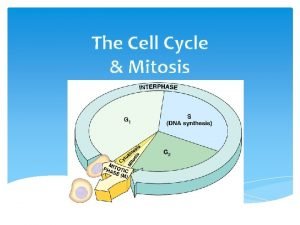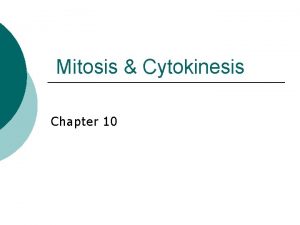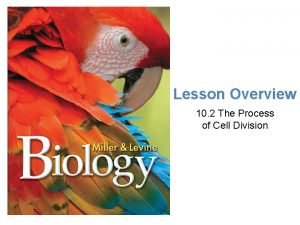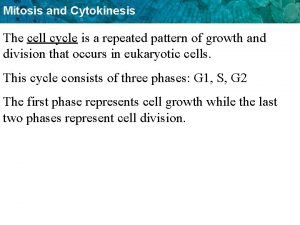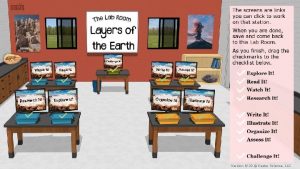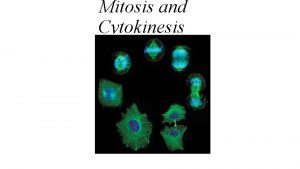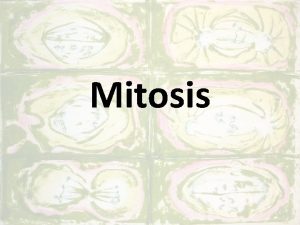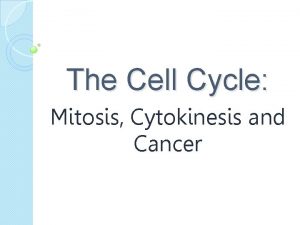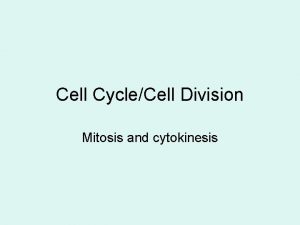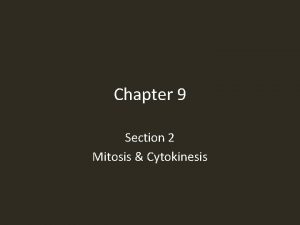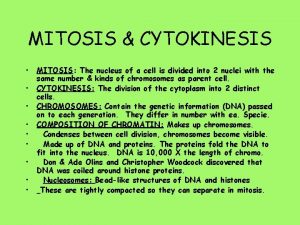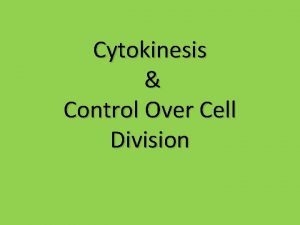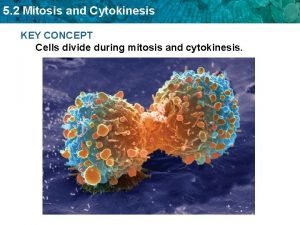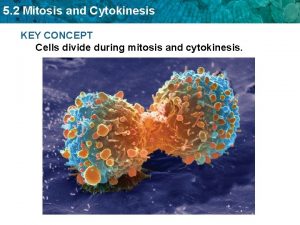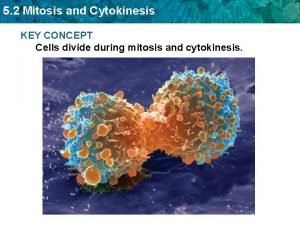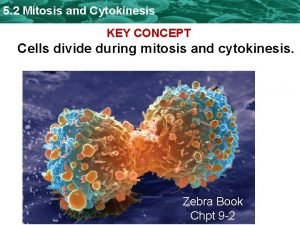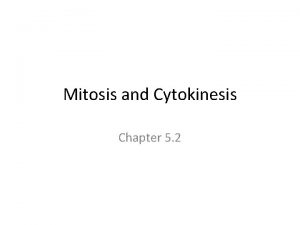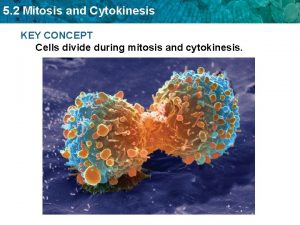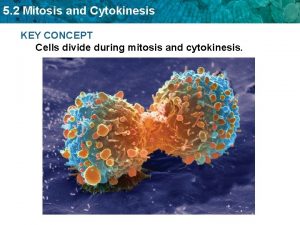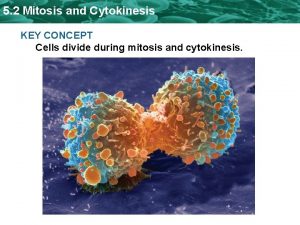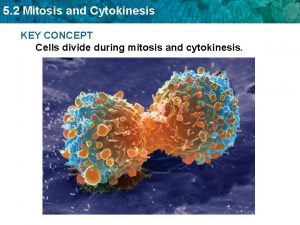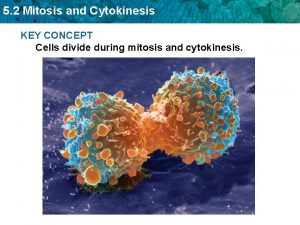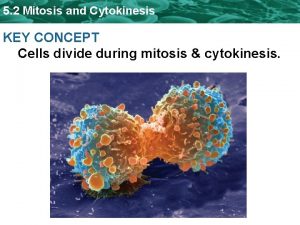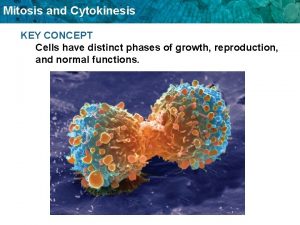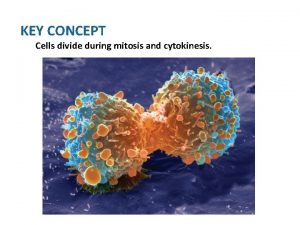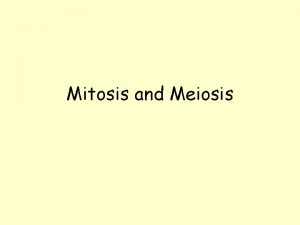9 2 MITOSIS AND CYTOKINESIS WHAT KEY EVENTS


























- Slides: 26

9 -2 MITOSIS AND CYTOKINESIS WHAT KEY EVENTS HAPPEN IN THE CELL DURING MITOSIS AND CYTOKINESIS?

JOURNAL Come up with as many synonyms for the word “copy” as you can.

JOURNAL COPY

EUKARYOTIC CELL CYCLE What do you already know?


MITOSIS CHALLENGE What key events happen during each stage of mitosis? 1. Obtain a note sheet, mitosis flashcards, microscope and onion root tip slides 2. Use the flashcards to complete your note sheet for the FIRST stage of the cell cycle (Interphase). 3. Using your microscope, identify a cell that is undergoing this stage. Verify with Mrs. Miller 4. Move onto the next stage and repeat.

INTERPHASE Cell grows and carries out cellular functions DNA and centrioles replicate Preparation for division

A. MITOSIS Prophase Chromatin condenses into chromosomes; sister chromatids attached at the centromere Nuclear membrane disintegrates Nucleolus disappears Centrioles move to poles of cell and spindle begins to

MITOSIS B. Metaphase: Chromosomes attach to spindle apparatus and line up at equator of cell

MITOSIS C. Anaphase: Microtubules shorten, pulling sister chromatids apart. Individual chromosomes move to poles of the cell

MITOSIS D. Telophase: Chromosomes reach poles of cell and “relaxes” into chromatin Nuclear envelop reforms, nucleolus becomes visible Cell membrane begins to pinch

CYTOKINESIS Splits one cell into two Animal Cell – membrane pinches inward Plant Cell – Cell plate forms


RESULT Each daughter cell has identical set of chromosomes View it in action

LABEL EACH PHASE OF MITOSIS AND PLACE THE STAGES IN THE CORRECT ORDER.

Chapter Cellular Reproduction Chapter Diagnostic Questions Which is the first phase of mitosis? A. interphase B. prophase C. metaphase D. telophase 1. A 2. B 3. C 4. D

Chapter Cellular Reproduction Chapter Diagnostic Questions During what phase do the sister chromatids line up in the middle of the cell? A. interphase B. metaphase C. anaphase D. telophase 1. A 2. B 3. C 4. D

Chapter Cellular Reproduction Chapter Diagnostic Questions Which is not a phase of the cell cycle? A. cytokinesis B. interphase C. apoptosis D. mitosis 1. A 2. B 3. C 4. D

Chapter Cellular Reproduction Section 1 Formative Questions Which can more efficiently supply nutrients and expel waste products? A. larger cells B. smaller cells C. cells with lower surface area to volume ratio 1. A D. cells shaped like a cube 2. B 3. C 4. D

Chapter Cellular Reproduction Section 1 Formative Questions At what stage does a cell spend most of its life? A. cytokinesis B. interphase C. mitosis D. synthesis 1. A 2. B 3. C 4. D

Chapter Cellular Reproduction Section 1 Formative Questions What happens in the cell during cytokinesis? A. The cell grows and carries out normal functions. B. The cell copies its DNA and forms chromosomes. C. The cell’s nucleus and nuclear material 1. A 2. B divide. D. The cell’s cytoplasm divides. 3. C 4. D

Chapter Cellular Reproduction Section 2 Formative Questions In what stage of the cell cycle does the cell’s replicated genetic material separate? A. cytokinesis B. interphase C. mitosis D. prophase 1. A 2. B 3. C 4. D

Chapter Cellular Reproduction Section 2 Formative Questions Which diagram shows anaphase? A. C. B. D. 1. A 2. B 3. C 4. D

Chapter Cellular Reproduction Section 2 Formative Questions At the end of mitosis the nuclear material is divided and two new cells have formed. A. true B. false 1. A 2. B

Chapter Cellular Reproduction Chapter Assessment Questions This cell has completed what stage of mitosis? A. anaphase B. interphase C. metaphase D. telophase 1. A 2. B 3. C 4. D

Chapter Cellular Reproduction Standardized Test Practice Which occurs in plant cells but not animal cells during the cell cycle? A. formation of a cell plate B. formation of microtubules C. formation of a cleavage furrow at the equator of the cell 1. A 2. D. movement of chromosomes to the poles of. B the 3. C cell 4. D
 Chapter 9 section 2: mitosis and cytokinesis
Chapter 9 section 2: mitosis and cytokinesis Whats the process
Whats the process Chromosome parts
Chromosome parts Handwriting คือ
Handwriting คือ Plant cell mitosis
Plant cell mitosis Cytokinesis usually but not always follows mitosis
Cytokinesis usually but not always follows mitosis Anaphase
Anaphase Separate picture
Separate picture Telophase and cytokinesis
Telophase and cytokinesis What happens during telophase?
What happens during telophase? Interphase to cytokinesis
Interphase to cytokinesis What phase is
What phase is What occurs after cytokinesis is completed?
What occurs after cytokinesis is completed? Cytokinesis
Cytokinesis Mitosis
Mitosis Pmat mitosis
Pmat mitosis Cytokinesis
Cytokinesis What is metaphase plate
What is metaphase plate Why is cytokinesis the shortest phase
Why is cytokinesis the shortest phase Mutually exclusive vs non mutually exclusive
Mutually exclusive vs non mutually exclusive Kesler science the lab room answer key
Kesler science the lab room answer key Meaning of diploid and haploid
Meaning of diploid and haploid Key partners adalah
Key partners adalah Key partners
Key partners Who fought in the punic wars
Who fought in the punic wars Review exercise terms and events answer key
Review exercise terms and events answer key Lesson 1 mitosis answer key
Lesson 1 mitosis answer key
